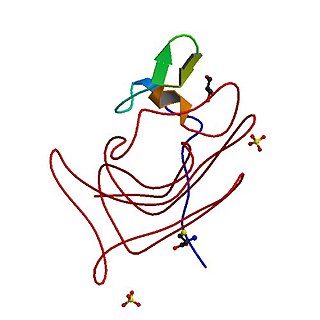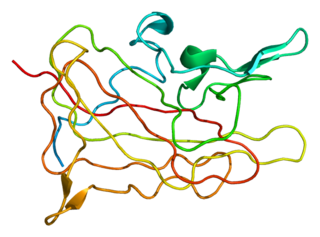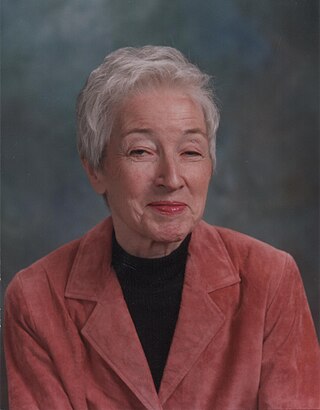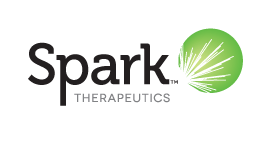Related Research Articles

Gene therapy is a medical technology that aims to produce a therapeutic effect through the manipulation of gene expression or through altering the biological properties of living cells.

Haemophilia, or hemophilia, is a mostly inherited genetic disorder that impairs the body's ability to make blood clots, a process needed to stop bleeding. This results in people bleeding for a longer time after an injury, easy bruising, and an increased risk of bleeding inside joints or the brain. Those with a mild case of the disease may have symptoms only after an accident or during surgery. Bleeding into a joint can result in permanent damage while bleeding in the brain can result in long term headaches, seizures, or a altered level of consciousness.

Haemophilia A is a blood clotting disorder caused by a genetic deficiency in clotting factor VIII, thereby resulting in significant susceptibility to bleeding, both internally and externally. This condition occurs almost exclusively in males born to carrier mothers due to X-linked recessive inheritance. Nevertheless, rare isolated cases do emerge from de novo (spontaneous) mutations.

Haemophilia B, also spelled hemophilia B, is a blood clotting disorder causing easy bruising and bleeding due to an inherited mutation of the gene for factor IX, and resulting in a deficiency of factor IX. It is less common than factor VIII deficiency.

Coagulation factor VII is a protein involved in coagulation and, in humans, is encoded by gene F7. It is an enzyme of the serine protease class. Once bound to tissue factor released from damaged tissues, it is converted to factor VIIa, which in turn activates factor IX and factor X.

Adeno-associated viruses (AAV) are small viruses that infect humans and some other primate species. They belong to the genus Dependoparvovirus, which in turn belongs to the family Parvoviridae. They are small replication-defective, nonenveloped viruses and have linear single-stranded DNA (ssDNA) genome of approximately 4.8 kilobases (kb).
Leber congenital amaurosis (LCA) is a rare inherited eye disease that appears at birth or in the first few months of life.
Recombinant factor VIIa (rfVIIa) is a form of blood factor VII that has been manufactured via recombinant technology. It is administered via an injection into a vein. It is used to treat bleeding episodes in people who have acquired haemophilia, among other indications. There are several disimilar forms, and biosimilars for each. All forms are activated.

Jeanne Marie Lusher, M.D. was an American physician, pediatric hematologist/oncologist, and a researcher in the field of bleeding disorders of childhood, and has served as the director of Hemostasis Program at the Children's Hospital of Michigan until her retirement on June 28, 2013.
Turoctocog alfa is a recombinant antihemophilic factor VIII used for the treatment of and prophylaxis of bleeding patients with haemophilia A. It is marketed by Novo Nordisk. It was approved in the United States, the European Union, and Japan in 2013.
Betibeglogene autotemcel, sold under the brand name Zynteglo, is a gene therapy for the treatment for beta thalassemia. It was developed by Bluebird Bio and was given breakthrough therapy designation by the US Food and Drug Administration in February 2015.
Katherine A. High is an American doctor-scientist who is an emeritus professor at the Perelman School of Medicine at the University of Pennsylvania. She was the co-founder, president, and chief scientific officer of Spark Therapeutics and currently serves as President of Therapeutics at AskBio. Her career has focused on pioneering work in the area of gene therapy, with many accomplishments in basic, translational, and clinical investigation in gene therapy.

Spark Therapeutics, Inc. is a developer of gene therapy treatments, which treat debilitating genetic diseases. It is a subsidiary of Hoffmann-La Roche.

Sangamo Therapeutics, Inc. is an American biotechnology company based in Brisbane, California. It applies cell and gene therapy to combat haemophilia and other genetic diseases.

Abrocitinib, sold under the brand name Cibinqo, is a medication used for the treatment of atopic dermatitis (eczema). It is a Janus kinase inhibitor and it was developed by Pfizer. It is taken by mouth.
A respiratory syncytial virus vaccine, or RSV vaccine, is a vaccine that protects against respiratory syncytial virus. RSV affects an estimated 64 million people and causes 160,000 deaths worldwide each year.
Damoctocog alfa pegol, sold under the brand name Jivi is a recombinant DNA-derived, Factor VIII concentrate used to treat hemophilia A.
Valoctocogene roxaparvovec, sold under the brand name Roctavian, is a gene therapy used for the treatment of hemophilia A. It was developed by BioMarin Pharmaceutical. Valoctocogene roxaparvovec is made of a virus (AAV5) that has been modified to contain the gene for factor VIII, which is lacking in people with hemophilia A. It is an adeno-associated virus vector-based gene therapy. It is given by intravenous infusion.
Etranacogene dezaparvovec, sold under the brand name Hemgenix is a gene therapy used for the treatment of hemophilia B. Etranacogene dezaparvovec is an adeno-associated virus vector-based gene therapy which consists of a viral vector carrying a gene for clotting Factor IX. The gene is expressed in the liver to produce Factor IX protein, to increase blood levels of Factor IX and thereby limit bleeding episodes. Hemophilia B is a genetic bleeding disorder resulting from missing or insufficient levels of blood clotting Factor IX, a protein needed to produce blood clots to stop bleeding.
Dirloctogene samoparvovec, also known as SPK-8011, is an experimental gene therapy developed for hemophilia A by Roche and Spark Therapeutics.
References
- 1 2 3 "Beqvez Product information". Health Canada . 22 October 2009. Archived from the original on 3 March 2024. Retrieved 3 March 2024.
- ↑ "Notice: Multiple additions to the Prescription Drug List (PDL) [2024-02-28]". Health Canada . 28 February 2024. Archived from the original on 2 March 2024. Retrieved 2 March 2024.
- ↑ "Details for: Beqvez". Health Canada . 27 December 2023. Archived from the original on 3 March 2024. Retrieved 3 March 2024.
- ↑ "Regulatory Decision Summary for Beqvez". Drug and Health Products Portal. 27 December 2023. Archived from the original on 2 April 2024. Retrieved 2 April 2024.
- 1 2 3 "Beqvez- fidanacogene elaparvovec-dzkt kit". DailyMed. 7 May 2024. Retrieved 18 May 2024.
- ↑ "Fidanacogene elaparvovec". CADTH. 20 June 2023. Archived from the original on 2 March 2024. Retrieved 2 March 2024.
- 1 2 "Beqvez". U.S. Food and Drug Administration (FDA). 25 April 2024. STN: 125786. Archived from the original on 29 April 2024. Retrieved 29 April 2024.
 This article incorporates text from this source, which is in the public domain .
This article incorporates text from this source, which is in the public domain . - ↑ "U.S. FDA Approves Pfizer's Beqvez (fidanacogene elaparvovec-dzkt), a One-Time Gene Therapy for Adults with Hemophilia B" (Press release). Pfizer. 26 April 2024. Archived from the original on 29 April 2024. Retrieved 29 April 2024– via Business Wire.
- ↑ George, Lindsey A.; Sullivan, Spencer K.; Giermasz, Adam; Ducore, Jonathan M.; Teitel, Jerome M.; Cuker, Adam; et al. (2 December 2016). "Spk-9001: Adeno-Associated Virus Mediated Gene Transfer for Hemophilia B Achieves Sustained Mean Factor IX Activity Levels of >30% without Immunosuppression". Blood. 128 (22): 3. doi:10.1182/blood.V128.22.3.3. ISSN 0006-4971.
- ↑ von Mackensen, Sylvia; Ducore, Jonathan M.; George, Lindsey A.; Giermasz, Adam; McGuinn, Catherine; Rasko, John E. J.; et al. (28 November 2023). "Health-Related Quality of Life in Adults with Hemophilia B after Receiving Gene Therapy with Fidanacogene Elaparvovec". Blood. 142 (Supplement 1): 3628. doi: 10.1182/blood-2023-179431 .
- ↑ George, Lindsey A.; Sullivan, Spencer K.; Giermasz, Adam; Samelson-Jones, Ben J.; Ducore, Jonathan M.; Teitel, Jerome M.; et al. (8 December 2017). "Spk-9001: Adeno-Associated Virus Mediated Gene Transfer for Hemophilia B - 1 Year Follow up and Impact of Baseline Characteristics on Transgene-Derived Factor IX Activity and Persistence". Blood. 130: 601. doi:10.1182/blood.V130.Suppl_1.601.601 (inactive 31 January 2024). ISSN 0006-4971. Archived from the original on 8 December 2023. Retrieved 8 December 2023.
{{cite journal}}: CS1 maint: DOI inactive as of January 2024 (link) - ↑ George, Lindsey A.; Sullivan, Spencer K.; Rasko, John E.J.; Giermasz, Adam; Samelson-Jones, Benjamin J.; Ducore, Jonathan M.; et al. (13 November 2019). "Efficacy and Safety in 15 Hemophilia B Patients Treated with the AAV Gene Therapy Vector Fidanacogene Elaparvovec and Followed for at Least 1 Year". Blood. 134 (Supplement_1): 3347. doi: 10.1182/blood-2019-124091 .
- 1 2 "Durveqtix EPAR". European Medicines Agency. 30 May 2024. Retrieved 31 May 2024. Text was copied from this source which is copyright European Medicines Agency. Reproduction is authorized provided the source is acknowledged.
- ↑ "New gene therapy treatment for haemophilia B". European Medicines Agency (Press release). 31 May 2024. Retrieved 1 June 2024.